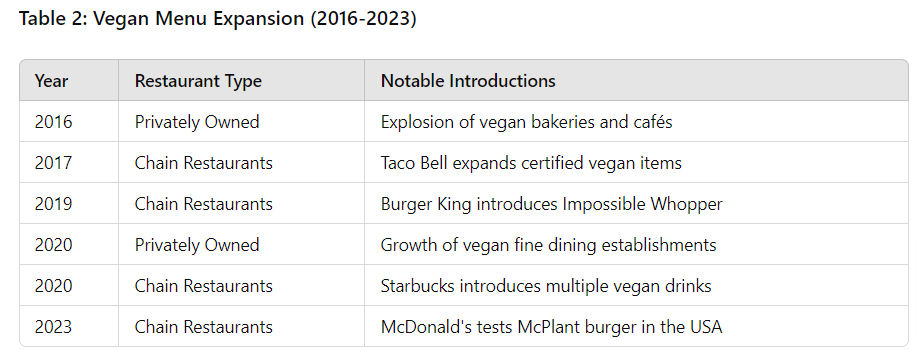The Evolution of Vegan Food Options in U.S. Restaurants: A Decade of Change
Over the past decade, vegan options have revolutionized U.S. restaurant menus, attracting health-conscious and eco-friendly diners like never before.

Over the last decade, the landscape of vegan food options in the United States has undergone a significant transformation. What was once a niche market has blossomed into a mainstream demand, influencing menus from small, privately-owned establishments to large national chains. For restaurant owners contemplating the addition of vegan dishes to their menus, understanding this trend is crucial for staying competitive and appealing to a broader customer base.
The Early 2010s: The Seed is Planted
In the early 2010s, veganism was still largely seen as a fringe movement. Most restaurants offered limited, if any, vegan options, often restricted to basic salads or vegetable sides. However, a growing awareness of health, environmental, and ethical issues began to shift consumer preferences. Documentaries like "Forks Over Knives" and influential public figures endorsing plant-based diets helped to spark initial interest.
Mid-2010s: Growing Demand and Initial Responses

Late 2010s: Mainstream Adoption
By the late 2010s, veganism had moved firmly into the mainstream. A Nielsen report in 2017 revealed a 20% increase in sales of plant-based foods compared to the previous year. Major chains responded by rolling out comprehensive vegan menus nationwide. Privately-owned restaurants, often more agile and innovative, became hotspots for unique and gourmet vegan dishes.
Fast food chains like Burger King introduced the Impossible Whopper in 2019, which became an instant hit. Similarly, Dunkin' launched a Beyond Sausage breakfast sandwich, catering to the growing vegan breakfast market.
The 2020s: Vegan Options as Standard Fare
Entering the 2020s, the COVID-19 pandemic accelerated trends towards health-conscious and sustainable eating. Consumers increasingly sought out plant-based options, both for health reasons and due to supply chain disruptions that highlighted the vulnerabilities of the meat industry. According to the Plant Based Foods Association, the market for plant-based foods grew 27% in 2020 alone.
Privately-owned restaurants continued to innovate, with many establishing themselves as entirely vegan or offering substantial vegan menus. Chains like Starbucks, McDonald's, and KFC introduced vegan options globally, further cementing plant-based foods in everyday dining.

Why Adding Vegan Options is a Smart Move
For restaurant owners, the shift towards veganism represents a significant opportunity. Offering vegan options can attract a new demographic of health-conscious and environmentally aware customers. It also positions a restaurant as forward-thinking and responsive to consumer trends. Moreover, with advancements in plant-based products, creating delicious and satisfying vegan dishes has never been easier.
By incorporating vegan options, restaurants not only diversify their menu but also contribute positively to environmental sustainability and public health. This strategic move can enhance a restaurant’s reputation, increase customer loyalty, and ultimately, boost sales.
References
- Mintel. (2015). Plant-Based Foods: An Overview.
- Nielsen. (2017). Plant-Based Foods Sales Growth.
- Plant Based Foods Association. (2020). Market Growth Report.
The last decade has seen veganism rise from a niche market to a mainstream dietary preference, driven by health, environmental, and ethical considerations. For restaurant owners, adding vegan options is not just a trend but a strategic decision that can lead to greater success and customer satisfaction in the years to come.
Vegan Gently Blog
















